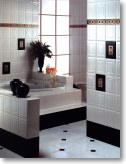|
|
|
||
ceramic tile floors
Ceramic Tile Flooring Ceramic tile floors have become much
more popular with consumers today, and this is in large part due to the vast
improvements that have been made not only in their design and color, but
also the strength at which they are being manufactured. The industry has evolved tremendously from the days of the nubby soft pink
bisque and primitive glazing techniques similar to the 8 by 8 Pergamina
(ancient by today's standards). Ceramic tile floors have become much
more popular with consumers today, and this is in large part due to the vast
improvements that have been made not only in their design and color, but
also the strength at which they are being manufactured. The industry has evolved tremendously from the days of the nubby soft pink
bisque and primitive glazing techniques similar to the 8 by 8 Pergamina
(ancient by today's standards).
Tile made of Porcelain in sizes 16 by 16
and larger exceed the wear ratings of the previous softer bisque
and glazed choices of yesterday by leaps and bounds. For instance,
it wasn't unusual for products made 20 years ago to begin showing signs of
wear in high traffic areas in 3 or 4 years after installation. The
glazed surface would actually wear down enough to become dull and
unsightly. Chipping was also a problem whenever something was dropped on
it. A room 12 by 12 in size will actually appear larger to the eye because of being less busy, more open and spacious when using lets say a piece 16 by 16 than it would if you had used a 12 by 12 square. The number of grout lines is drastically reduced as the size of the piece increases, creating this allusion. The basic rule of thumb is this... The larger the square - the fewer the grout lines, the fewer the grout lines - the less busy, the less busy - the more open and spacious, the more open and spacious - the larger a room looks. Ceramic Tile Wear Ratingstoday is rated by the Porcelain Enamel Institute (PEI) for wearability. This is a number rating scale that goes from a PEI classification of 0 (not good) to 5 (very good). What do these numbers mean? They basically indicate the areas of use recommended by the manufacturer. For instance, one rated PEI 2 should only be considered for an area where very low traffic and soiling is expected. In this classification will be the high gloss selections with vibrant colors which are aesthetically pleasing, but not long wearing.On the other hand, a PEI 5 indicates something designed for heavy commercial wear and traffic. Most good quality Porcelain will have a wear rating of 5, meaning it is the strongest you can buy. It must be mentioned though, that the rating system is only for determining wear expectations, not the actual quality of the product. The factors determining quality are calibration (are all pieces the same size), squareness of edges (is there any warpage), and consistency of surface texture (are there imperfections such as small visible cracks in the glaze).Ceramic Tile QualityQuality then, is just as important a consideration as the wear rating is, for a number of reasons. First, when the installer considers the lay-out of a particular job, his first priority should be setting the individual pieces as close as what is reasonable. Grout joints are required in all floor applications, with anything 1/4 inch or smaller acceptable. At no time should squares be butted together, for when the floor settles (and they all do) shearing (coming up off the floor) and buckling will occur.At any rate, let's
say each of the pieces are consistent in size with one another. This is a good
thing, for because they are calibrated well, the installer can set
a close joint (lets say 3/16 of an inch or even a little closer) and all
of the grout lines will be uniform. It's not unusual though for a poor
quality line to have squares within the same shipment and dye lot vary
as much as an 1/8 of an inch from one another. Calibration is
terrible (some would say unacceptable) and the end result will be larger
and considerably more inconsistent size grout lines. Installers
have to be much more selective in deciding which pieces to install and
which to set aside when dealing with poorer quality choices. This slows
down the job considerably, ultimately costing the installer not only
time but money. Installers are not magicians, and cannot make that which
is crooked and warped, straight. They can only deal with the variables
that are present and make the best of it. Kitchen Flooring Ideas | Bathroom Flooring Ideas | Dining Room Flooring Ideas
� 2010 FloorBiz, Inc. All Rights Reserved Flooring | Flooring Guide | Flooring Info | Flooring Forum
| |||
|
|
|